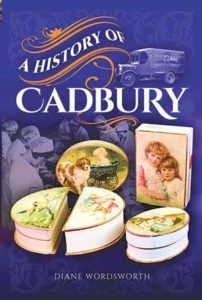A History of Cadbury
Reviewed by Beth Taylor
August 1, 2019
By Diane Wordsworth. Pen and Sword History, 2018. 176 pages. $39.95/hardcover; $24.95/paperback (available in September); $19.17/eBook.
Buy from QuakerBooksIn 1824 John Cadbury sold tea, coffee, and drinking chocolate in a small shop in Birmingham, England. As a Quaker, he marketed chocolate as a healthy alternative to alcohol. The Quaker values of temperance, exercise, and intentional community surrounded by nature would define the evolution of Cadbury into a global business. Each generation of the family changed recipes and technology, added products, and expanded their market according to the knowledge and demands of the era.
Diane Wordsworth, a broadcast journalist and freelance writer, has written an instructive history of how the company began, how it grew, and how they diversified in order to survive.
In 1879 the Cadburys moved to Bournville, England, and created their “factory in a garden,” the first of their many precedents in the history of business. They built a meetinghouse and affordable housing surrounded by landscaped yards for their workers. They built schools and playing fields, and gave their workers time each day for sports and classes. They created health clinics and housing for retired workers. In each generation, they paid better than contemporary wages and created pensions.
The best parts of this book are personal. In primary documents, the Cadburys propose or report upon their innovations: “I beg respectfully to state that the progress of the use of machines for sweeping chimnies [sic] in this town has been for the last six years gradually on the increase.” In reminiscences, workers describe the process of how chocolate was made in their time; the innovations of machinery; the classes in business management and chemistry; the fun of football (i.e., soccer) and swimming; or the kindness and support of the Cadbury bosses, who knew each worker by name and visited each family in their home.
Here’s one memory from Lily Houghton (no date given):
I can well remember my first morning commencing work at Cadbury Brothers, Bridge Street. I . . . was taken to the Flour Room . . . and I was delighted to be working amongst the sugar and the flour. . . . All the girls seemed very friendly and happy.
I remember Mr. G. Cadbury being very strict concerning any sugar cremes or chocolate being allowed to remain on the floor. To encourage us he gave us [extra money] if we kept our floors clean, and if we did have sugar or chocolate on the floor he would fine us 6d each.
I remember at the following Christmas Party the Firm told us then of their intention to build new works in the country. . . . All through the spring we talked a lot about going to work . . . where there were fields and lanes, and sometimes we got so excited about it that the forewoman . . . told us that we should never go to Bourneville if we did not behave ourselves, so of course for a time we went very quiet.
The story of Cadbury chocolate includes its ancient roots as “food for the gods,” its changes in production from slave-based cocoa plantations to free labor, and its modern evolution from additives to purity. The twentieth century brought mergers and changes in branding, so now Cadbury is intertwined with Schweppes and Kraft. Today, the youngest descendant of the family sells his organic chocolates in London.
Cadbury’s origin in temperance is similar to that of Kellogg’s, Post’s, and Welch’s, and its social influence and civic work environment is similar to Hershey’s in the United States. But Cadbury led the way. In 2024, Cadbury will be celebrating 200 years since the first store opening, and this book reminds us how Quaker influence through business, education, and community planning were exemplified through one extended family and its delicious chocolate.




Comments on Friendsjournal.org may be used in the Forum of the print magazine and may be edited for length and clarity.